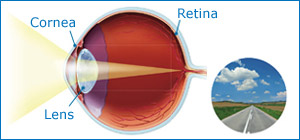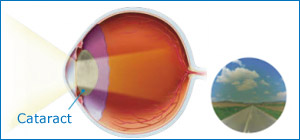What is a Cataract?

A cataract is a clouding of the normally clear, transparent lens of the eye. A cataract is not a tumour or growth of new tissue over or in the eye. Rather it is a fogging or loss of clarity of the lens itself. The lens is located in the eye just behind the iris and the pupil. Cataract is usually related to the aging process. Almost 50% of the people develop a cataract by the age of 55-60 years. If left untreated, cataracts can eventually lead to blindness. If impaired vision interferes with your usual activities, you might need cataract surgery. The only permanent correction for cataracts is to undergo cataract surgery. Cataract surgery has progressed to a point where it is one of the safest of all medical procedures. It involves removing the cloudy lens and replacing it with a clear lens.
Fortunately, these days with highly advanced technology, cataract surgery is generally an extremely safe and effective procedure with excellent visual recovery. We offer the most advanced procedures for cataract surgery with multiple lens options including the advanced multifocal, toric and accommodative Intra Ocular Lenses. The procedure is virtually painless and comfortable for the patient. Modern cataract surgery only takes a few minutes to perform. Your vision usually returns to the way it was before cataracts by the next day.
Prior to your procedure, we will help you decide which IOL (Intra Ocular Lens) will work best for you. In years past, there was little choice as to what IOL to use in cataract surgery. Older IOL models are referred to as “monofocal IOLs” and focus vision at a single distance; if a patient chooses a monofocal IOL to correct for far distance vision, reading glasses are required after surgery to focus up close. Recent technological advances have resulted in “Premium IOLs” that have advantages over monofocal IOLs. Premium IOLs include multifocal and accommodating IOLs, which help focus vision for both far distance and up close, resulting in less dependence on glasses after cataract surgery. Toric IOLs help correct astigmatism, again resulting in less dependence on glasses after cataract surgery. During your eye exam, Dr. Khatib can let you know if you are a candidate for one of these exciting Premium IOLs.
Healthy Eye

- Light enters the eye through the cornea, passes through the natural crystalline lens and is accurately focused onto the retina, providing a crisp, clear image.
Eye with Cataract

- As the eye ages, the lens becomes cloudier, allowing less light to pass through. The light that does make it to the retina is diffused or scattered, leaving vision defocused and blurry.
Causes of Cataract?
There are many types of cataracts. Most are caused by chemical changes in the lens that result from the normal process of aging. These cataracts can rarely occur as early as age 30.
There is now evidence that prolonged exposure to ultraviolet light can contribute to cataract formation. Ultraviolet light is a normal, invisible component of sunlight. Most exposure to ultraviolet light occurs when outdoors between 10:00 a.m. and 2:00 p.m., particularly in the summer season. Exposure to ultraviolet light can be reduced by wearing a hat with a brim and glasses that filter out ultraviolet light.
Other causes of cataracts include eye injuries and certain infections or diseases, such as diabetes. In rare instances, children can develop cataracts. If these are present at birth, they are called congenital cataracts.

Symptoms of Cataract?
The most common symptom of a cataract is cloudy or blurred vision. Some people notice a haziness or cloudiness of their vision, as if their glasses are constantly in need of cleaning. Double vision can occur as the cataract is forming. Glare or sensitivity to bright lights is another common complaint; at night, there may be haloes around lights or scattering of the light from the headlights of oncoming cars.
Some cataracts first affect reading or other types of close work. Other types of cataracts initially interfere with driving or seeing at a distance. Sometimes changing the glasses is helpful in restoring some vision. However, as the cataract worsens, stronger glasses may no longer improve sight.
Most patients first notice Cataracts when :
 Vision becomes slightly blurred
Vision becomes slightly blurred
 Colors seem faded
Colors seem faded
 Night vision deteriorates
Night vision deteriorates
 Halos appear around lights
Halos appear around lights
 Glare increases
Glare increases
 Double vision occurs (also known as diplopia)
Double vision occurs (also known as diplopia)


